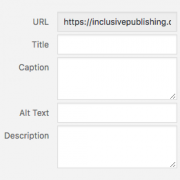Rethinking Content for Inclusive Higher Education Part Two
 In March, textBOX examined the challenges in delivering accessible web content for print-disabled college students in Part 1 of Rethinking Content. This second article focuses on practical solutions for universities and publishers that impact the future of inclusive higher education.
In March, textBOX examined the challenges in delivering accessible web content for print-disabled college students in Part 1 of Rethinking Content. This second article focuses on practical solutions for universities and publishers that impact the future of inclusive higher education.
At the March 2019 CSUN Assistive Technology Conference, Pearson, McGraw-Hill and Macmillan presented accessibility milestones and initiatives. Jonathan Thurston, Head of Global Product Accessibility at Pearson, announced their commitment to publish born-accessible digital content, as well as strategic partnerships forged with Kurzweil, VitalSource and T-Base Communications. Lisa Nicks, Director of Accessibility at McGraw-Hill, described the challenges of transforming publishing from a print to digital workflow and announced several new company directions, including EPUB 3 certification through Benetech’s Global Certified Accessible program, EPUB 3 accessibility metadata and new quality assurance policies and procedures. Macmillan’s Rachel Comerford, Senior Director of Content Standards and Accessibility, announced their commitment to delivering born-accessible digital content and meeting Macmillan’s timelines for accessible product releases.
Major academic publishers are overcoming significant barriers to accessible publishing and have changed their organizational culture and approach. The publishing industry has reached a tipping point with delivering inclusive higher education. Accessibility is no longer considered a niche area and is now a central factor in usability and intuitive design. We are at a critical juncture for tackling more specific issues while providing proactive solutions that will have a wide-ranging impact on the higher education community. Universities and publishers now need to seize the potential of this moment and move forward together with a renewed, unified direction and purpose.
Major Obstacles to Inclusive Higher Education
While universities and publishers are making progress with delivering accessible content, major obstacles are creating a vicious cycle and consuming valuable time, money and resources. The graphic below illustrates the challenges faced:

Solutions for Universities
Implement Proactive Accessibility Policies and Procedures
Proactive accessibility policies and procedures can save time for universities in the long run and have the power to influence widespread adoption of industry standards, such as EPUB 3 and WCAG 2.1. Adoption of inaccessible content creates a continual strain on university resources and risks of legal exposure. Now is the time for universities to raise procurement standards and expectations to keep pace with increasing publisher accessibility practices. The AEM Center’s Quality Indicators provide a comprehensive guide for creating proactive accessibility policies with links to useful resources.
The recommendations and examples on the checklist below save valuable Disability Service Office (DSO) resources while furthering the availability of accessible content for the entire higher education community:
- Ensure university accessibility statement requires vendors to meet WCAG 2.1 AA. Example: CSU Vendor Accessibility Requirements.
- Allow sufficient time for alternative format development. Contact publishers as soon as DSO or faculty identify the adoption of non-compliant products.
- Establish procedures for evaluating content collaboratively with publishers. Example: CSU ATI Procurement Process.
- Include requirements in new and existing publisher contracts for content accessibility and remediation as well as delivery timelines.
- Create faculty guidelines and incentives to adopt accessible content. Example: TBR Procurement Considerations.
- Designate DSO staff to build effective publisher partnerships. Conduct regular publisher meetings, establish requirements and expectations, create an action plan and timeline and track progress.
Allocation of Staff Resources and Technical Expertise
Taking time for a transition stage is necessary while the long-term benefits of a proactive approach take effect. Therefore, universities must plan ahead to resolve content remediation issues collaboratively with publishers.
First and foremost, universities must prioritize the use of industry standards, EPUB 3 and Accessibility 1.0, over PDF to continue positive momentum. While PDF remediation may seem like a quick fix it does not contribute to increasing the availability of mainstream accessible content in the long term. Prioritizing EPUB 3 will require changes to existing procedures. For example, universities can create an action plan that involves requesting accessible EPUB content and Voluntary Product Accessibility Templates (VPAT) from publishers and the provision of appropriate training to staff and students on how to use EPUB files.
It is also imperative for the DSO to have at least one employee who has experience with EPUB files and industry accessibility standards. For eTextbooks, AccessText and Benetech’s Bookshare offer a wide range of EPUB content that DSOs can take advantage of using. Additionally, Ace by DAISY is a helpful free and open source tool for automatically checking the accessibility of EPUB files.
Accountable Remediation
If universities are forced to continue to remediate EPUB 3 content, publishers should be held responsible. Universities must require resolution in a timely manner. If the publisher does not respond, online retailers may be able to assist the university by contacting the publisher to remediate the problem. If universities allow time to request EPUB 3 files early in the adoption process, this will contribute to increasing accessible content availability on the market. A remediated PDF file must be a last resort and temporary solution for the university. Publishers should be responsible for providing accessible content for every non-compliant product adoption. The DSO should notify the instructor and the adoption should be identified as at risk if the university is not able to acquire an accessible EPUB 3 file in a timely manner.
Universities must also hold publishers accountable for quality assurance (QA). EPUB files must be tested by publishers and print-disabled users on multiple platforms with assistive technologies to ensure all functions and accessibility features are working consistently. If there are issues encountered in the QA process, the university should be notified and the publisher should work to resolve the issue. Publishers, platforms and assistive technologies should not work in isolation. They all play a critical role in delivering an accessible learning experience for the user.
Solutions for Publishers
Publishers have made major improvements in recent years. Many have established a central accessibility task force responsible for listening to university partners, secured executive sponsorship, promoted accessibility across the organization and budgeted for improvements for WCAG non-compliant digital products. Publisher commitments to born-accessible content have raised the bar in an ever-competitive marketplace. For publishers who have not tackled these issues yet, now is the time to move forward to remain relevant.
While publishers have prioritized accessibility and made improvements to digital content and technologies, they now must tackle communication and transparency as well as improve responsiveness to university requests and vendor management.
Enhanced Communication and Transparency
Publishers need to be more transparent with providing accessibility specifications for digital products and platforms to eliminate the need for university evaluation and consumption of DSO time. Populating digital product accessibility metadata in ONIX (codelist 196), on retail websites and/or within EPUB files is an industry standard requirement that improves the discoverability and sales of digital products while reducing the number of DSO requests for alternative formats.
Publisher sales representatives must be aware of accessibility requirements so they can inform and answer questions and avoid misleading prospective adopters. Representatives are on the front lines selling digital products to universities and must be instructed to notify the publisher accessibility team of problems. Educating sales representatives demonstrates support for university policies, procedures and resources. It is not acceptable to expect the university to shift resources to handle emergency remediation when this should have been handled at the front end by publishers.
Accessibility statements on publisher websites require improvement. The ASPIRE Project evaluated publisher websites for accessibility information, including accessibility contact details, enquiry response times, file navigability and image descriptions. The results revealed that publishers scored an average of 3.3 out of a total of 35 (ASPIRE). Publishers must implement the ASPIRE guide for updating website product information (available here).
Publishers can improve communication with universities by listening more actively. For example, publishers can host a session with universities to collect accessibility feedback. They can also participate in specialist conferences like Accessing Higher Ground and CSUN. Maintaining a constructive, collaborative dialogue between publishers and universities is the key to successful partnership and change.
Timely Response to Remediation
A born-accessible approach is a giant leap forward for inclusive higher education, however, there must be a solution for fixing existing inaccessible content and platforms. Universities are continually battling deadlines and are forced to triage internally when publishers do not provide usable content.
Publishers must establish both reactive and proactive approaches to university requests. If publishers take a reactive approach, they must also develop a solution to quickly respond to requests and meet university deadlines. Publishers must be prepared to receive rush requests from universities that may only have a few days before the start of class. Collaboration with partners in the education sector is key here. Everyone needs to help each other to be successful in these time-critical situations.
On the other hand, a proactive approach is more desirable because it reduces the amount of content remediation and helps them remain competitive with other publishers. This approach involves creating a prioritized list of published content and then budgeting to remediate selections on an annual basis. Regardless of approach, updating existing content will save time and money when the next edition is published.
To improve responsiveness, publishers should assign a primary contact person for university requests. This person must have a direct line of communication with the publisher’s internal department or an external vendor responsible for resolving accessibility issues. The contact person must be diligent about submitting requests and informing the university of expected delivery dates. This will build trust, ensure satisfaction and reduce the amount of time it takes to deliver an accessible file to the student.
Vendor and In-House Quality and Consistency Issues
As Bill Kasdorf states, vendor management is a critical aspect in publishing accessible content at scale: “many people don’t realize that most publishers don’t actually do the hands-on production work for their books and journals – their vendors do that. But what is a lot of work for the publishers is, frankly, training their vendors. We owe a big debt of gratitude to all the publishers–Hachette Livre in trade and the Big Five higher education publishers (Cengage, Macmillan Learning, McGraw-Hill, Pearson, and Wiley) particularly come to mind – who have spent years working closely with their vendors to get accessibility right. Now all the other publishers who use those vendors will have an easier path to making their publications born accessible.”
Vendors have a responsibility to maintain the publisher’s brand and reputation and aim to deliver consistent, high-quality digital products that meet accessibility requirements. To address university complaints about the quality of digital products, publishers should implement regular quality assurance checks to evaluate whether vendors are meeting expectations. Publishers must push back on vendors to resolve concerns and, when necessary, add accessibility requirements to vendor contracts.
Publishers should also require vendors to be responsible for remediation and to adhere to delivery timelines that meet university expectations. Addressing issues with vendors proactively will save time for publishers and universities.
Conclusion
We cannot let current challenges prevent us from making the changes we all want to see in the future. We can overcome obstacles together through communication, collaboration and action. Universities must be more consistent and proactive to prevent unnecessary strain on time and resources. Publishers must be more transparent and responsive to maintain their relevance. Solving these problems will make a difference for both disabled and non-disabled readers while establishing a new standard for inclusive higher education.
This article was kindly submitted by Caroline Desrosiers and Huw Alexander, Co-Founders of textBOX. To learn more about textBOX please visit the textBOX website or reach out at hello@textboxdigital.com



